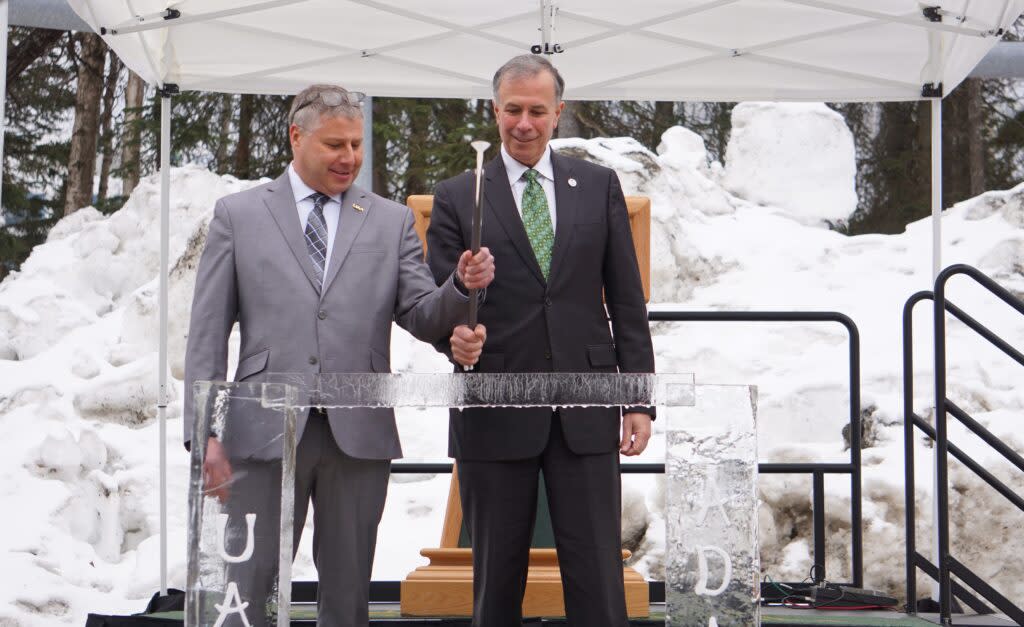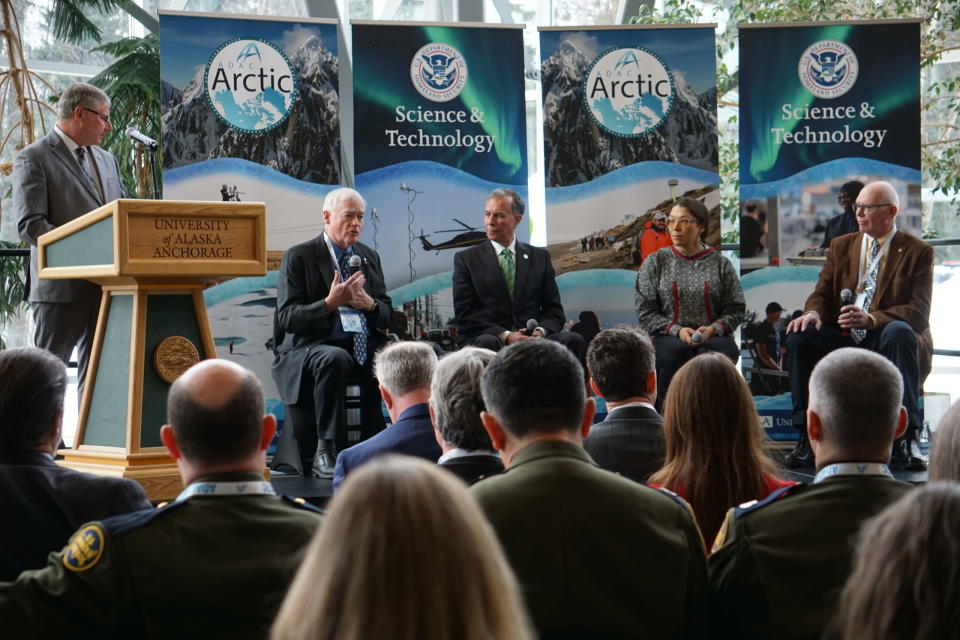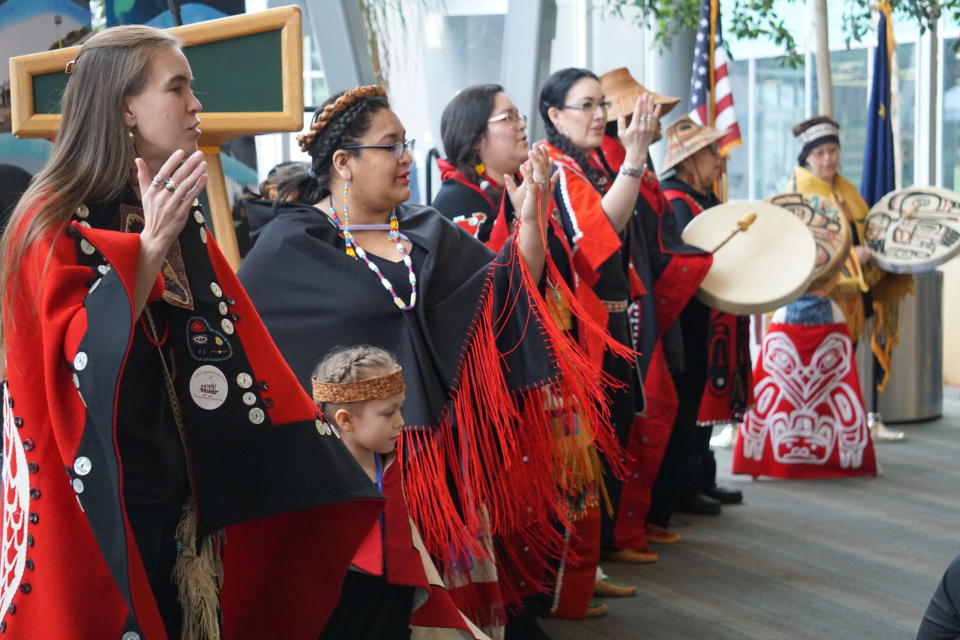New Homeland Security research center marks opening at University of Alaska Anchorage

Jeff Libby, a University of Alaska assistant professor, and Dimitri Kusnezov, undersecretary for science and technology at the U.S. Department of Homeland Security, wield a hammer to break a span of ice at a campus ceremony on Tuesday marking the startup of the new ADAC-ARCTIC research center, which Libby heads. The acronym stands for Arctic Domain Awareness Center -Addressing Rapid Change through Technology, Innovation and Collaboration. The new organization is one of the Department of Homeland Security's nine operating Centers of Excellence. (Photo by Yereth Rosen/Alaska Beacon)
When the federal government established an Arctic Domain Awareness Center 10 years ago at the University of Alaska Anchorage, the mission focused on maritime issues in the changing Arctic Ocean and how the U.S. Coast Guard would manage them.
Now a new Arctic Domain Awareness Center has started operations at UAA, and the research mission is much broader, reflecting new knowledge about the wide-ranging impacts of Arctic climate change on what the federal government classifies as homeland security.
“The world has changed. And what we think about being important has evolved,” Dimitri Kusnezov, undersecretary for science and technology at the U.S. Department of Homeland Security, told reporters on Tuesday.
Kusnezov was a featured speaker at a ceremony held Tuesday at UAA that marked the opening of the new center. It has been given a long name: Arctic Domain Awareness Center – Addressing Rapid Changes through Technology, Information and Collaboration, which is abbrieviated as ADAC-ARCTIC.

Expert panelists speak at Tuesday’s ceremony about the homeland security subjects to be examined at the new ADAC-ARCTIC center at the University of Alaska Anchorage. From left are Jeff Libby, the principal investigator for the center; former Alaska Lt. Gov. Mead Treadwell, a former chair of the U.S. Arctic Research Commission; Dimitri Kusnezov, undersecretary for science and technology at the U.S. Department of Homeland Security; Elizabeth Qaulluq Cravalho, vice president for lands at NANA Regional Corp. and a member of the U.S. Arctic Research Commission; and Larry Hinzman, assistant director for polar sciences at the White House Office of Science and Technology Policy and a former vice chancellor at the University of Alaska Fairbanks. (Photo by Yereth Rosen/Alaska Beacon)
As Kusnezov and other speakers described it, ADAC-ARCTIC will be a hub for collaborative research on numerous Arctic subjects influenced by climate change. Among them are customs and border patrol issues, natural disaster response, cybersecurity, workforce development and more. A critical element of the work, the speakers said, is cooperation with Indigenous partners and reliance on Indigenous knowledge.
“ADAC-ARCTIC represents a hub of creativity, knowledge and expertise where the brightest minds come together to tackle some of the most pressing issues facing our nation Jeff Libby, the center’s principal investigator, said at the on-campus ceremony.
“Through research, innovation and collaboration, we will confront emerging threats, strengthen our security infrastructure and enhance the safety and well-being of our communities. Today, as we break this ice together, let us reaffirm our commitment to excellence, integrity and service,” he said.”
The Department of Homeland Security is devoting $46 million over 10 years to the project.

University of Alaska Fairbanks Caitlynn Hanna, who is from the Kotzebue, lights a traditional Inupiat seal-oil lamp at the start of Tuesday’s ceremony at the University of Alaska Anchorage marking the opening of the ADAC-ARCTIC research center there. Hanna is pursuing a masters degree in civil engineering and worked previously as a fellow with the earlier Arctic Domain Awareness Center that operated at UAA. The new center is designed to have a stronger focus on Indigenous collaboration and knowledge. (Photo by Yereth Rosen/Alaska Beacon)
Although the opening ceremony was held Tuesday, featuring a symbolic breaking of a span of ice and celebratory toasts with sparkling cider encased in cups formed out of ice, the center has actually been operating for months, said Libby, an associate professor who holds other research leadership positions at UAA.
Staff members and partners have been working in an off-campus office in East Anchorage ever since the Department of Homeland Security in January announced that it had selected UAA as the host university for the center, Libby said.
The ADAC-ARCTIC Center is s one of nine Centers of Excellence established by the Department of Homeland Security and currently operating.
The centers, which are university- or college-based research hubs, are meant to be temporary, Kusnezov said. They are generally funded for 10 years, with the intent of creating knowledge, connections and systems that will be used by more permanent institutions, he said.
UAA was selected through a competitive process, and the other candidate that emerged was the University of Alaska Fairbanks, said Rebecca Medina, the Department of Homeland Security’s director of university programs.
The previous Arctic Domain Awareness Center at UAA had been put into what the Department of Homeland Security refers to as “emeritus status,” with low levels of operation until the new center was established.

The Lepquinm Gumilgit Gagoadim Tsimshian Dancers perform at the April 9. 2024, ceremony at the University of Alaska Anchorage marking the opening of the ADAC-ARCTIC research center. (Photo by Yereth Rosen/Alaska Beacon)
Along with addressing challenges like thawing permafrost, rapidly eroding coastlines, disrupted fisheries and fish runs and dangers of increased shipping in waters that are ice-free over vaster areas for longer periods of time, the new center will be operating at a time of heightened international tensions in the Arctic, speakers at Tuesday’s event said.
Russia, the biggest Arctic nation, has become hostile, making cross-border collaboration more difficult, said Mead Treadwell, a former lieutenant governor and former chair of the U.S. Arctic Research Commission. That includes work in the eight-nation Arctic Council, an institution based on consensus, Treadwell said.
“We have a situation now where one member of the Arctic Council has totally violated international law. That makes it hard to trust that any agreements under international law will hold, whether they’re in Antarctica or here or arms control or anything else. I think we just have to work very hard to make sure that good science is there for decisions, and we can avoid conflicts,” he said.
GET THE MORNING HEADLINES DELIVERED TO YOUR INBOX
The post New Homeland Security research center marks opening at University of Alaska Anchorage appeared first on Alaska Beacon.

